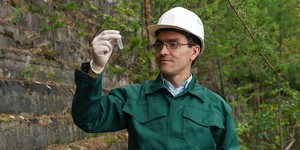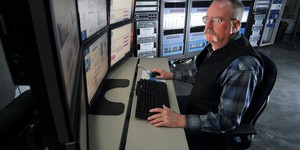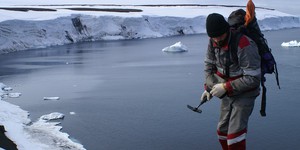Abstract
You might know that we are able to get renewable energy from the Sun, the wind, and water, but did you know we can get renewable energy from Earth itself? The temperature inside of Earth can reach 9,000°F—that kind of heat can be used to make a lot of energy here on the surface! This source of energy is called geothermal energy and it is all about taking advantage of the heat within Earth. So try this science fair project out and find out how to use the heat that lies beneath your feet!Summary
Michelle Maranowski, PhD, Science Buddies

Objective
The goal of this science fair project is to build a model of a geothermal power plant to learn more about geothermal energy.
Introduction
The word geothermal is comprised of the Greek words geo, meaning "earth," and thermal meaning "heat." Earth has four different sections: crust, mantle, outer core, and inner core. The first section, the crust, keeps us insulated from the interior heat of the earth. The crust is what we stand on every day. The second section, the mantle, starts at a depth of 1,250 miles and is semi-molten. The third section, the outer core, starts at a depth of 2,500 miles and is liquid. And finally, the inner core is solid and is made up of nickel and iron. It starts at a depth of 4,000 miles and is 9,000°F.
Many features on the crust demonstrate the heat and power within the earth: geysers, fumaroles, and mud pots, to name a few. While each is a different result of the heat from within the earth, the source of the heat is the same.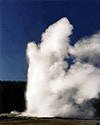 Image Credit
Image Credit
Figure 1. The Old Faithful geyser in Yellowstone National Park. (DOE/NREL, credit Joel Renner, 1997.)
Geothermal energy is a kind of energy that is renewable and sustainable because it relies on water moving through the water cycle and the interior heat of the earth. All water on Earth is part of the global water cycle; thus, water is a renewable resource. Rainwater seeps miles into the earth. After being heated inside of the earth, the rainwater resurfaces as steam or as hot water, which ultimately lead to some of the features on the crust, mentioned above. Sometimes hot water and steam get trapped in permeable and porous rock under a layer of impermeable rock. This is called a geothermal reservoir. Geothermal reservoirs can reach temperatures of up to 700°F.
Geothermal energy is obtained by tapping into a geothermal reservoir and using the hot water or steam within it to operate a turbine. As the turbine rotates, it generates electricity. These turbines are located at geothermal plants. There are three different kinds of geothermal plants: dry steam, flash steam, and binary cycle. In all cases, the plant becomes part of a cycle where hot water or steam from the reservoir comes in, creates electricity, is cooled, and is then sent back to the reservoir. When the cooled water comes back to the reservoir, it is heated and the cycle starts again. Another advantage of geothermal energy is that the power plants don't emit any greenhouse gases into the air. The only material that geothermal energy plants emit is water vapor.
In this science fair project, you will make a model of a geothermal reservoir and a geothermal energy plant. You will do an experiment to learn more about geothermal energy. Use steam and an empty can to make a pinwheel spin. You'll soon discover how much power the heat beneath your feet really has!
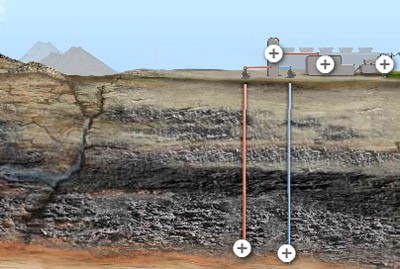 Image Credit: Chevron Corporation / Chevron Corporation, Copyright 2010. Used with permission.
Image Credit: Chevron Corporation / Chevron Corporation, Copyright 2010. Used with permission.
Figure 2. This screenshot is from a brief animation, courtesy of Chevron Corporation, that shows how steam is captured from beneath the ground and turned into electricity by a steam turbine. (Chevron Corporation, 2009.)
Terms and Concepts
- Geothermal
- Crust
- Mantle
- Outer core
- Inner core
- Molten
- Geyser
- Fumarole
- Mud pot
- Renewable
- Sustainable
- Water cycle
- Permeable
- Porous
- Impermeable
- Geothermal reservoir
- Turbine
- Greenhouse gas
Questions
- What is geothermal energy?
- What are the different parts of the Earth?
- What are the advantages of geothermal energy? What are the disadvantages?
- What are the three different types of geothermal plants? How do they use hot water or steam to create electricity?
Bibliography
The following websites have a lot of good information on geothermal energy:
- The Geothermal Education Office. (2008). Geothermal Energy. Retrieved July 7, 2008.
- Science Clarified. (n.d.). Geyser and hot spring. Retrieved July 7, 2008.
The U.S. Department of Energy has information on the geothermal energy, along with the history of geothermal energy in the United States.
- U.S. Department of Energy Office of Energy Efficiency & Renewable Energy. (n.d.). Geothermal Technologies Office. Retrieved March 20, 2018.
Materials and Equipment
- Clean metal can with one lid removed, 14.5-ounces; available at any grocery store
- Hammer
- Nail, 1/8-inch diameter
- Wood ruler or thin piece of wood, 12 inches long
- Rubber bands (2)
- Medium-sized pot, 3 quarts
- Aluminum foil
- Stove top
- Pinwheel, available at toy stores or novelty stores
- Note: many store-bought pinwheels require a strong, consistent breeze to make them spin. The steam coming from the pot in this project might not be enough to make them spin. If you buy a pinwheel that does not work, you can try making your own homemade pinwheel using an aluminum pie pan, like the one in the Science Buddies project Take a Candle Carousel for a Spin. See the Procedure for more details.
- Permanent marker
- Timer
- Oven mitts
- Lab notebook
- Graph paper, or you can create it online by visiting Create a Graph: https://nces.ed.gov/nceskids/CreateAGraph/default.aspx
Experimental Procedure
Note: You will be working with a hot stove top. Please exercise caution when working with hot surfaces and with steam. Steam can cause painful burns.
- Using the hammer and nail, make a hole at the edge of the lid that is still attached. Make another hole directly opposite the first hole. Both holes should be no larger than 1/8 inch in diameter.
-
Attach the ruler, vertically, to the side of the can, using rubber bands. Position the ruler so that it is between the two holes. Make sure that the bottom edge of the ruler is flush with the bottom edge of the metal can. The can and ruler should not be tilted when placed on a flat surface. The open end of the can should be facing down. See Figure 3, below.
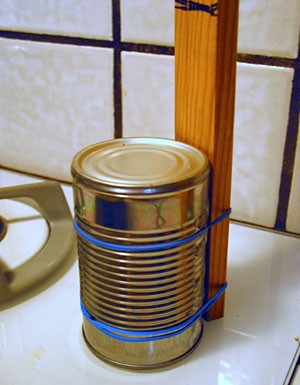 Image Credit: Michelle Maranowski, Science Buddies / Science Buddies
Image Credit: Michelle Maranowski, Science Buddies / Science Buddies
Figure 3. The can and ruler assembly is a model of a geothermal power plant.
- Fill your 3-quart pot with 2 quarts (or just over half full) of tap water. Take a piece of aluminum foil and place it on top of the pot. Crimp the foil down over the edges of the pot so that the water is sealed in. Take another piece of foil and place it on top of the first piece of foil. Crimp the second piece to ensure that when the water boils, no steam can get out from the edges. The foil-covered pot models the earth. The aluminum foil is the crust, covering the heat that is within the earth.
- Gently poke a hole in the center of the aluminum foil pieces, using the nail. Make sure that the nail goes through both layers of aluminum foil. The hole should be no larger than 1/8 inch in diameter.
- Turn the stove top on medium to medium high and place the pot on top of the flame or hot surface. Note the setting of the stove top in your lab notebook in a data table like the one shown below. The heat setting should be hot enough to boil water; however, make sure that the water doesn't boil so heavily that water hits the foil.
- Make one large mark on the back of the pinwheel at the base of the spokes with the permanent marker. You want to be able to see the mark clearly while the pinwheel is spinning.
- Wait for the water to boil. When you see steam coming out of the hole and the foil cover is slightly inflated, you are ready to start the experiment.
- Get your timer ready. Place the can and ruler on top of the hole in the foil. Let the can sit undisturbed for 30 seconds. This represents a power plant collecting steam from a reservoir in the earth.
-
Now it's time to test your model. Hold the pinwheel, facing down, above the can over both holes. See Figure 4, below. Make sure that the ruler is not in the way of the pinwheel and that the pinwheel is parallel to the can's top. If necessary, push the ruler down gently so that the can doesn't move too much. The pinwheel will start spinning. Note the height at which you are holding the pinwheel. You can use the ruler to determine the height. Write this number down in your lab notebook.
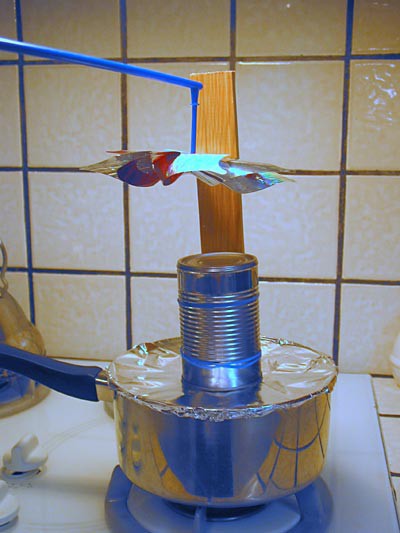 Image Credit: Michelle Maranowski, Science Buddies / Science Buddies
Image Credit: Michelle Maranowski, Science Buddies / Science BuddiesA steel can sits atop a pot covered with aluminum foil. The foil has a hole for steam to escape and the can traps the steam which then escapes through a hole in the top of the steel can. The escaping steam blows over a pinwheel held directly above the steel can causing it to spin.
Figure 4. This image shows the experimenter testing the geothermal power plant model.
- If your pinwheel does not spin at all, it might have too much friction to be powered by the steam in this project. You will need to make your own homemade pinwheel that spins more easily. You can do this by following the procedure in the Science Buddies project Take a Candle Carousel for a Spin. To make it easier to hold the homemade pinwheel over a pot of boiling water, you can puncture a straw with the wooden skewer, as shown in Figure 5. This will allow you to hold the pinwheel from the side, but make sure you still wear oven mitts.
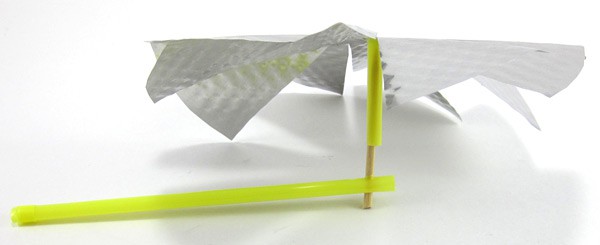 Image Credit: Ben Finio, Science Buddies / Science Buddies
Image Credit: Ben Finio, Science Buddies / Science Buddies
Figure 5. An example of a homemade pinwheel made using an aluminum pie plate, a straw, and a wooden skewer.
- You're ready to start the experiment. First note the location of the mark on the back of the pinwhe el. Each time you see that mark reach that location again, the pinwheel has made a complete spin. Count the number of complete spins in 20 seconds. Use the timer to keep track of time and the mark you made on the pinwheel to count the number of spins. Record the number of complete spins in 20 seconds in your lab notebook. Repeat this step two more times and record the information in your lab notebook.
-
Use the oven mitt and remove the can from the top of the pot and place it to the side. Now hold the pinwheel over the hole in the foil at the same height as in step 11. You might need a helper to hold the ruler near the pan, flush with the aluminum foil, but in the air, so you can see how high you should be holding the pinwheel. Count the number of complete spins the pinwheel makes in 20 seconds. Use the timer to keep track of time. Record the information in your lab notebook. Repeat this step two more times and record all information in your lab notebook. Holding the pinwheel over the bare foil without the can represents the power of geothermal steam from the earth without a power plant.
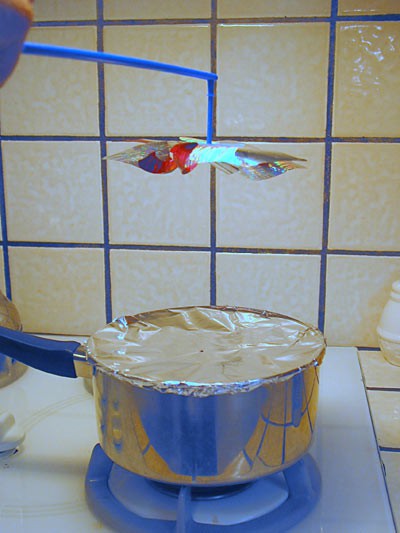 Image Credit: Michelle Maranowski, Science Buddies / Science Buddies
Image Credit: Michelle Maranowski, Science Buddies / Science Buddies
Figure 6. Counting the number of spins over bare foil.
- Take the pot off the flame or hot surface and let it cool down. After it has cooled down, you can leave the water that's in the pot, simply adding some more to fill the pot just past half full. Carefully undo the foil, add the water, and crimp the foil back onto the pot. Now use the nail and poke eight more holes in both aluminum foil layers around the edge of the pot. The holes should be no bigger than 1/8 inch in diameter. You can reuse the same pieces of aluminum foil, but if the foil rips, remove it and replace it with two layers of aluminum foil, poking a hole in the center, as in step 4. The holes in the foil represent openings in the earth over the geothermal reservoir. If there are many openings around a geothermal reservoir, there are many ways for steam and heat to escape (so this simulates a situation where not all the steam from a reservoir is collected by the power plant, and some just escapes into the atmosphere).
- Turn on the stove top to the setting recorded in your lab notebook from step 5. Once the water is boiling and there is steam coming out of the holes, place the can and ruler on top of the hole in the middle of the foil and pot. Use your timer and let it sit there for 30 seconds. Now hold the pinwheel above the can and the two holes at the same height as recorded in your lab notebook from step 11. Count the number of complete spins that the pinwheel makes in 20 seconds. Use the timer to keep track of time. Repeat this step two more times and record all information in your lab notebook.
- Use the oven mitt and remove the can from the pot and place it to the side. Now hold the pinwheel over the hole in the center of the foil at the same height as in step 11. Again, you might need a helper to hold the ruler near the pan, flush with the aluminum foil, but in the air, so you can see how high you should be holding the pinwheel. Get your timer ready. Count the number of complete spins the pinwheel makes in 20 seconds and write the value in your lab notebook. Repeat this step two more times and write all of the information in your lab notebook.
- Remove the pot from the flame or hot surface and let it cool down. Repeat step 12, this time poking 12 more holes in the foil around the edge of the pot (for a total of 20 holes around the edge) and repeat steps 13-14.
- What does poking holes around the edge of the foil do? Does it affect the number of pinwheel spins when the pinwheel is over just the foil? Does it affect the number of pinwheel spins when the pinwheel is above the can?
- Graph the information in your lab notebook on a scatter plot. If you need help with making or understanding scatter plots or would like to build your scatter plots online, go to the Create a Graph website.
- Make two different scatter plots, one showing the recorded data with the can on top of the pot and one without the can on top of the foil. For both plots, label the x-axis Holes Around the Edge and the y-axis, Average Number of Pinwheel Spins. The can on top of the foil models a geothermal power plant. What kind of conclusion can you make about how geothermal power plants work?
| Number of Holes Around the Edge | Number of Pinwheel Spins | |
|---|---|---|
| No Can, Bare Foil | With Can on Foil | |
| Average: | Average: | |
| Average: | Average: | |
| Average: | Average: | |
| Stove Top Setting= | Height of Pinwheel= | |
Ask an Expert
Global Connections
The United Nations Sustainable Development Goals (UNSDGs) are a blueprint to achieve a better and more sustainable future for all.
Variations
- Change the height that you place the pinwheel over the can and the central hole. What kind of change do you see?
- What happens if you change the size of the can? Does this affect the number of pinwheel spins?
Careers
If you like this project, you might enjoy exploring these related careers:



